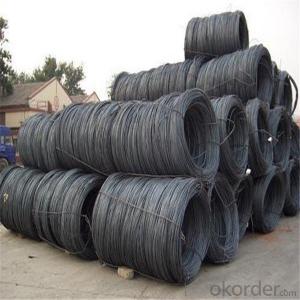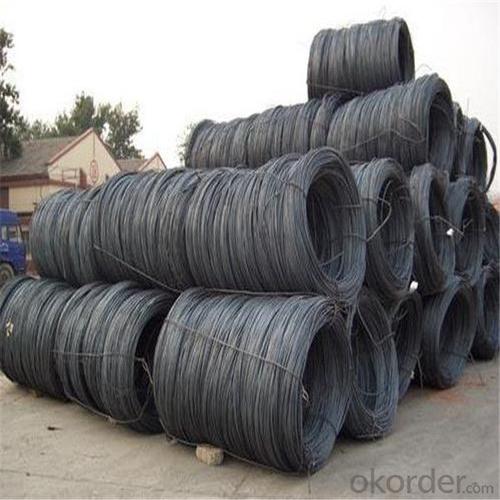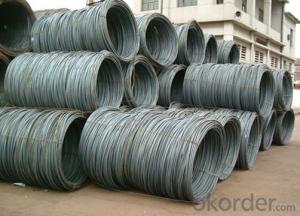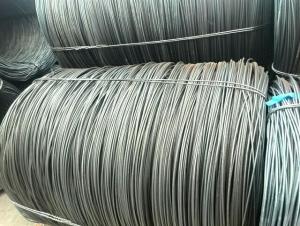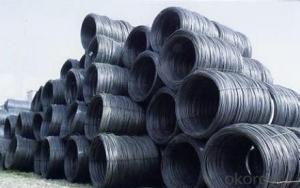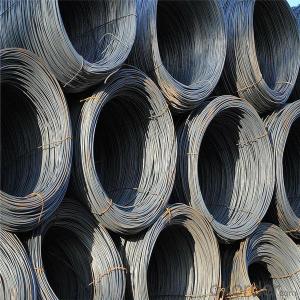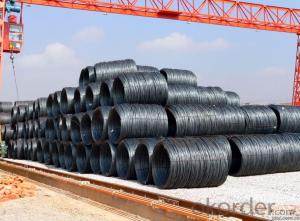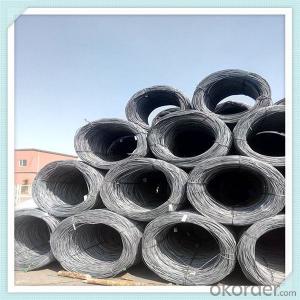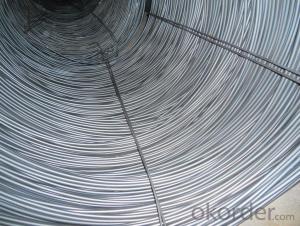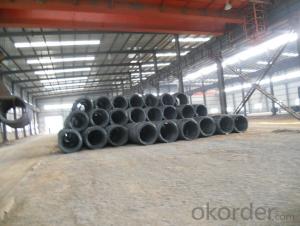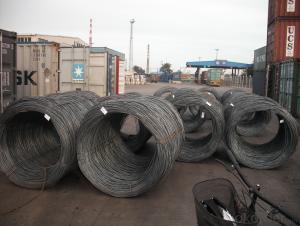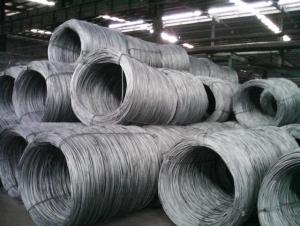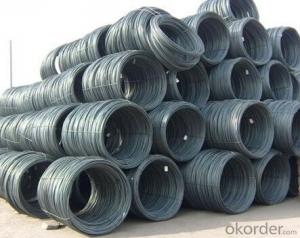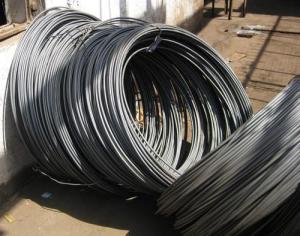Steel wire rod high carbon in different diamater
- Loading Port:
- Tianjin
- Payment Terms:
- TT OR LC
- Min Order Qty:
- 100 m.t.
- Supply Capability:
- 16532 m.t./month
OKorder Service Pledge
OKorder Financial Service
You Might Also Like
Specification
Drawing Grade wire rods are used by downstream industries for various applications such as making wires for
welded mesh, nails, hangers, screws, chain link & gabion fencing, wire nets, barbed wires and binding wires
Our Advantage: High quality steel products from 1 class mills in
Reasonable price
Professionalism of the products
On-time delivery
Complete documents and certificates
Sincere service to meet our clients' requirements
Product Description :
Standard | AISI, ASTM, BS, DIN, GB, JIS |
Material/steel grade | Q195-Q235,SAE1006B,SAE1006CR, SAE1008B, SAE1008CR, SAE1010B, SAE1018B, or according to customers requirements |
Wire Gauge | 5.5-12mm |
Coil weight | 1.8-2.1mts |
MOQ | 25MT |
Delivery Time | 15-30 days after receipt of L/C or deposit by T/T |
Packing | In coil and load in container, if large quantity, by bulk vessel; Can be packed as customers' special requirements |
Payment terms | 1).100% irrevocable L/C at sight. 2).30% T/T prepaid and the balance against the copy of B/L. 3).30% T/T prepaid and the balance against L/C |
Application | widely used in machinery parts, manufacturing industry, electronics industry, metal tools and others |
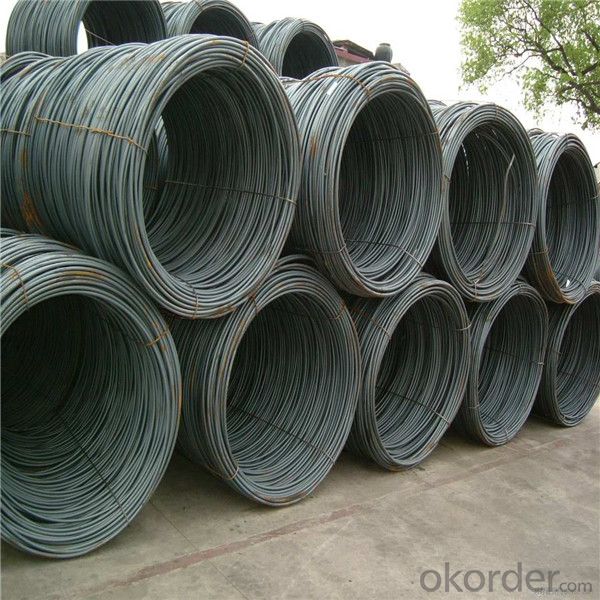

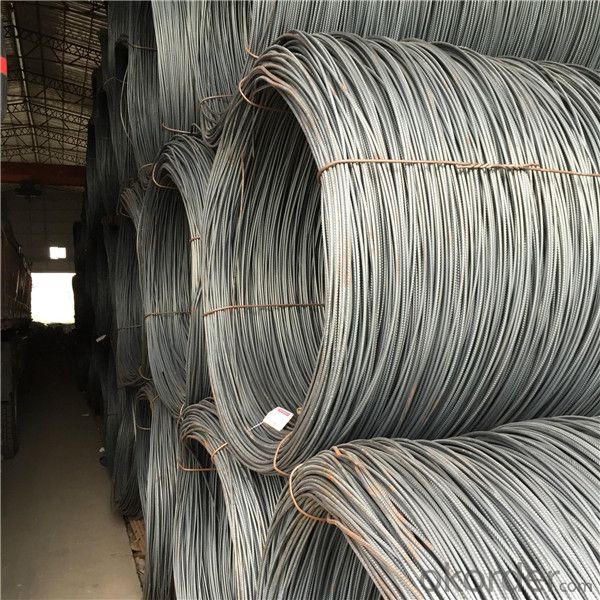
Application :
It generally used in braiding the hose for bathing product and machinery. With it
good flexibility, resistant to high temperature and resistant to corrosion, it
used widely in many industries.
Packing :
Hot-rolled wire rod is held in a unit with at least four steel straps in the
transverse direction and transported and stored without further packaging.
Before
the steel strapping is applied, the wire rod must be sufficiently compressed.
The strapping is fixed in the transverse direction with a single circumferential
strap so that the strapping does not slip and cause the coil to come apart.
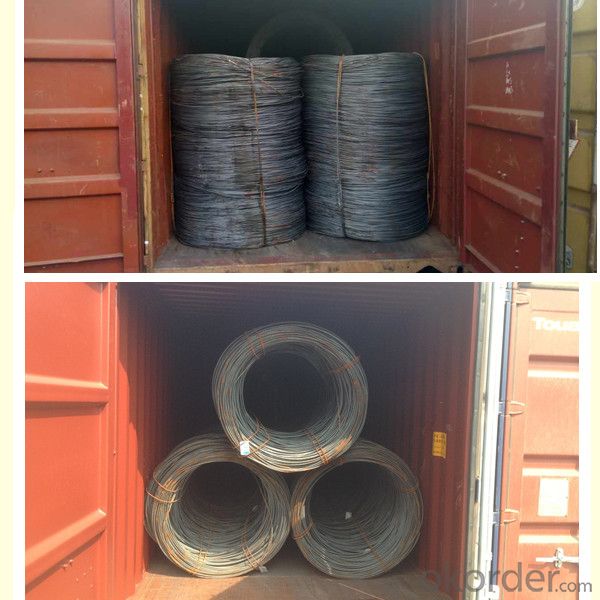

Our service:
(1) We cooperate with famous factories with advanced equipment and well trained workers.
(2) We can provide factory price with trading company service.
(3) We continuously work on the improvement of our processes, guaranteeing
consistently high standards of quality to keep none compensation.
(4) We guarantee 24 hours response and 48 hours solution providing service.
(5) We accept small order quantity before formal cooperation.
(6) We deliver the agreed quality at the agreed time, reacting to changes in
customer wishes in a flexible way.
(7) Due to our volume and selling power, we have excellent freight rates with
shipping lines.
(8) We strive to always be fair and honest in our dealings with customers.
(9) We strive to work together with customers to achieve much more than we can
achieve alone.
(10) Through our passion and commitment we aim to be a market leader in all our
key markets. To maintain our position as market leader we must continue to add
value in all that we do.
FAQ:
1.Q: What's your MOQ(minimum order quantity)?
A: One full container, mixed acceptable .
2. Q: What's your packing methods?
A: Packed in bundle or bulk ..
3. Q: How can I buy CNBM products in my country?
A:Please send us an inquiry or email ,we will reply to you if there is distributor in your country
4. Q: Can we visit your factory?
A: Warmly welcome. Once we have your schedule, we will arrange the
professional sales team to follow up your case.
5. Q: How long does it take to get the product if i place an order?
A:With the process of your requirements,we will pack and deliver in 3
-7 days. If it is by sea shipment,it will take 15-45 days depending on different locations
- Q: What are the main factors influencing the choice of steel wire rod order frequency?
- The frequency at which companies place orders for steel wire rods is influenced by several key factors. Firstly, demand and market conditions play a significant role. If there is a high demand for steel wire rods in the market, companies may need to place more frequent orders to meet customer requirements and maintain inventory levels. Additionally, market conditions such as price fluctuations and supply availability can also impact the order frequency. Secondly, the production capacity of the steel wire rod supplier and the lead time required for delivery can affect the order frequency. If a supplier has limited production capacity or a longer lead time, companies may need to place larger and less frequent orders to ensure a continuous supply. Thirdly, inventory management is another factor to consider. Existing inventory levels and storage capacity can influence the order frequency. If a company has limited storage space or wants to minimize inventory holding costs, they may choose to place more frequent orders in smaller quantities. Cost considerations also come into play. The cost of steel wire rods, including the purchase price, transportation, and any applicable taxes or duties, is a significant factor. Companies may analyze the cost of holding inventory versus the cost of frequent ordering to determine the most cost-effective approach. Lastly, the relationship between the company and the steel wire rod supplier can impact the order frequency. A strong and reliable partnership allows for more flexibility in adjusting the order frequency based on changing market conditions or business needs. In conclusion, the choice of steel wire rod order frequency is influenced by demand and market conditions, production capacity and lead time, inventory management, cost considerations, and supplier relationships. Companies must consider these factors to ensure a steady and efficient supply of steel wire rods.
- Q: What are the different types of steel wire rod surface treatments after wire drawing?
- There are several types of steel wire rod surface treatments after wire drawing, including galvanizing, zinc coating, phosphating, and powder coating. These treatments are applied to enhance the wire's corrosion resistance, increase durability, and improve its appearance.
- Q: What are the common applications of deformed steel wire rod?
- Deformed steel wire rods are commonly used in a variety of applications such as construction, reinforcement of concrete structures, manufacturing of nails, wire mesh, fencing, and various other industrial purposes.
- Q: What are the main competitors of steel wire rod?
- The main competitors of steel wire rod include aluminum wire rod, copper wire rod, and other non-ferrous metal wire rods. Additionally, synthetic materials like fiberglass and carbon fiber also pose competition in certain industries where lightweight and high-strength alternatives are preferred.
- Q: What are the main factors affecting the market research of steel wire rod?
- The main factors affecting the market research of steel wire rod include demand and supply dynamics, global economic conditions, price fluctuations, technological advancements, regulatory and environmental factors, competitor analysis, and customer preferences and behavior.
- Q: How is steel wire rod used in the manufacturing of wire connectors?
- Steel wire rod is used in the manufacturing of wire connectors as it serves as the raw material. The wire rod is processed and shaped to form the conductive components of the connectors, ensuring a secure and reliable electrical connection.
- Q: What are the advantages of using steel wire rod compared to other materials?
- There are several advantages of using steel wire rod compared to other materials. Firstly, steel wire rod offers high strength and durability, making it suitable for various applications where a strong material is required. Secondly, steel wire rod has excellent flexibility, allowing it to be easily bent or shaped without breaking, which makes it ideal for applications that require flexibility, such as in construction or manufacturing. Additionally, steel wire rod has good corrosion resistance, ensuring its longevity and suitability for outdoor or corrosive environments. Lastly, steel wire rod is widely available and cost-effective, making it a cost-efficient choice for many industries.
- Q: How is steel wire rod used in the manufacturing of wire forms for automotive cooling systems?
- Due to its excellent strength and durability properties, steel wire rod is commonly utilized in the production of wire forms for automotive cooling systems. These wire forms are crucial components that provide structural support and help maintain the desired shape and functionality of various cooling system parts. One notable application of steel wire rod in automotive cooling systems is seen in the manufacturing of radiator cores. Radiator cores consist of a network of small tubes and fins that efficiently transfer heat from the engine coolant to the surrounding air. These tubes and fins are often connected and supported by wire forms made from steel wire rod. Steel wire rod is chosen for this purpose due to its high tensile strength, enabling the wire forms to withstand the pressure and vibration experienced in automotive cooling systems. Additionally, steel wire rod exhibits excellent resistance to corrosion, ensuring the wire forms' longevity and reliability even in harsh operating conditions. In the manufacturing process, steel wire rod is initially shaped using specialized machinery. Subsequently, the wire undergoes various heat treatment procedures to enhance its strength and flexibility. Once the wire forms are fabricated, they are integrated into the radiator core assembly, providing support and stability to the tubes and fins. Furthermore, steel wire rod finds use in the production of other wire forms such as hose clamps, brackets, and hooks in automotive cooling systems. These wire forms play vital roles in securing hoses, connecting components, and providing structural support to ensure the proper functioning of the cooling system. Overall, steel wire rod is an indispensable material in the manufacturing of wire forms for automotive cooling systems. Its strength, durability, and corrosion resistance make it an ideal choice for supporting and maintaining the integrity of various cooling system components, ultimately contributing to the efficient operation of the automotive cooling system.
- Q: How is steel wire rod used in the manufacturing of wire displays?
- Steel wire rod is used in the manufacturing of wire displays as it serves as the primary material for creating the intricate wire structures and frames. The wire rod is cut, shaped, and welded to form the desired display designs, providing strength and stability to hold various products or items. Additionally, the steel wire rod can be coated or painted to enhance durability and aesthetics, ensuring that the wire displays are both functional and visually appealing.
- Q: How long is the shelf life of steel wire rod?
- The shelf life of steel wire rod is typically indefinite as long as it is stored properly and protected from environmental factors that could cause corrosion or damage.
Send your message to us
Steel wire rod high carbon in different diamater
- Loading Port:
- Tianjin
- Payment Terms:
- TT OR LC
- Min Order Qty:
- 100 m.t.
- Supply Capability:
- 16532 m.t./month
OKorder Service Pledge
OKorder Financial Service
Similar products
Hot products
Hot Searches
Related keywords
